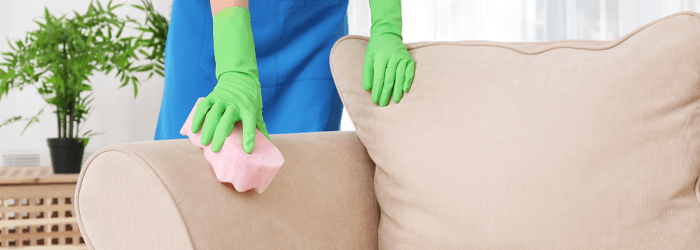Smart and Easy Tips To Help Your Furniture Last
Replacing furniture can get expensive. Save your money for as long as possible by keeping your furniture in good condition. Regular cleaning and repairs will go a long way. Follow these maintenance tips, and your furniture can last decades.
General Cleaning Tips
- Gently sweep surfaces using a soft-bristle brush and rinse with water.
- Combine 1/4 cup mild dishwashing liquid with one gallon of warm water. Use a sponge or a soft-bristle brush to scrub the furniture’s surface thoroughly. Rinse and pat dry with a lint-free cloth. We like the JAWS Microfiber Cloths.
- Do not power wash or use chlorine bleach, pine oil, or abrasive cleansers unless directed by the manufacturer.
- Test new solutions on a hidden area.
Wood Furniture
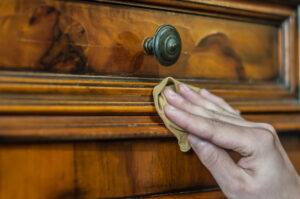
Rosie on the House Certified Partner, Irwin’s Furniture Restoration, offers the following tips to keep wood furniture looking its best.
Vacuum so you have a clean area to work with. Using a 100 percent cotton or soft microfiber cloth, dab it with a light amount of furniture oil. Don’t use cloths or pads that are abrasive and scratch finishes. Wipe in the direction of the grain. Do not use heavy hand pressure if there is a heavy layer of dust particles as they will scratch the finish. Wipe off lightly with a damp, soft cloth to remove debris. Then go back over with furniture oil.
Use pure oil such as Mohawk, Old English, or Guardsman to clean and dust. Steer clear of aerosol products. They contain added chemicals, which are harmful to the furniture’s finish.
Leather furniture
Keep the leather clean. Leather is a porous skin and is quite absorbent. Every week, use a damp white cloth to wipe off the surface. Every six months apply a quality brand off-the-shelf leather “cleaner” followed by a quality leather “conditioner”. We like Milsek.
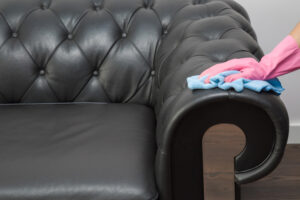
Never use harsh soap, detergents, cleaning solvents ammonia, or vinegar to clean stains from leather. These will severely dry out the leather and may remove the dye. The best cleaners for leather are tap water or store-bought cleaning solution. When using water, only dampen the cloth. Do not soak the leather during cleaning because too much water can cause stains.
Never leave newspapers or magazines on leather furniture. The dyes from the printed material can easily leech into the leather and permanently stain it. Leather can fade, stiffen, and crack, so keep it away from heat sources such as fireplaces, radiators, space heaters, and direct sunlight through the windows.
Wicker
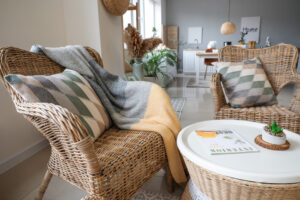
Vacuum wicker with a dust-brush attachment or dry paintbrush to remove dirt and debris. If needed, sand lightly with fine-grit sandpaper to remove peeling paint or stray fibers. Then wipe with a mixture of 25 percent white vinegar and 75 percent water, then wipe again with plain water.
If weaves are damaged or broken, repair them with wood glue such as Titebond or Loctite. Allow the glue to dry before cleaning with the mild soap solution. Avoid using too much water, which can weaken the fibers. Dry and touch-up paint, as necessary. For unpainted furniture, apply tung oil after washing and drying to protect them from the elements and provide a deep, rich protective finish.
Fabric
Airborne dirt and dust mites can settle in the small crevices of the upholstery fabric, causing allergies and irritations. Frequently remove cushions and vacuum with the brush and corner attachments. If you do not have a vacuum, use a nylon, soft but stiff bristle brush. Pull up pet hair with a lint roller or take a damp sponge and roll the hair off.
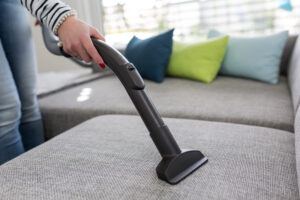
For pile or flocked fabric, do not use the vacuum. Gently use a soft nylon-bristled brush to remove the dust so the raised designs do not lift out with the dirt. Flocked fabric means that flocking has been applied with an adhesive, either all over or in a pattern.
Wipe spills and stains immediately.
Some covers are removable and washable. How you clean them depends on the fabric. Sew Guide notes that most can be washed in the washing machine with a delicate cycle unless it is marked “dry clean only” such as Rayon. Most upholstery fabrics have a loose weave and must be cleaned as you would a delicate fabric. For blended fabric, look at the blends, and treat the whole fabric according to which fiber is more delicate in the mix. Because cotton fabric can shrink with a water-based cleaning, replace the cover when it is still a little damp. Otherwise, it may no longer fit your couch.
Run a fan and open the windows to let in fresh, dry air, which will prevent mold and mildew.
Be cautious when using store-bought or DIY cleaners. The wrong cleaner could ruin the fabric. If you are unsure what to use, Sew Guide offers cleaning codes for the furniture industry.
Metal
If there are signs of rust, loose paint, or mold, remove it with a stiff wire brush. Then sand with fine-grit sandpaper until smooth.
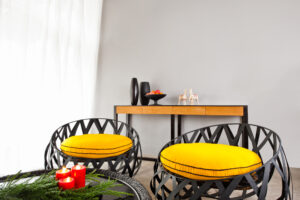
Using the mild soap solution, scrub, rinse, and dry. If touch-up paint is needed, try to get it through the manufacturer. Apply in several thin layers. Let dry between coats.
If you want to repaint the whole piece, apply an oil-based primer such as Rust-Oleum Clean Metal Primer. Follow up with one of the many colors available from Krylon and available in most home improvement stores. Because humidity may affect the paint, work on a dry day (not in July and August in Arizona).
After cleaning, apply a coat of high-quality liquid or paste auto wax with a lint-free cloth, per the manufacturer’s recommendation. Use a silicone spray to lubricate swivels and glides. Regularly inspect for rust or chips.
When in doubt about cleaning and repairing furniture, consult a professional cleaner, or contact the manufacturer.
Home Maintenance To-Do | #FurnatureMaintenance
###
Rosie-Certified Content Partners
Photo Credit:
- Shutterstock
RELATED CONTENT

